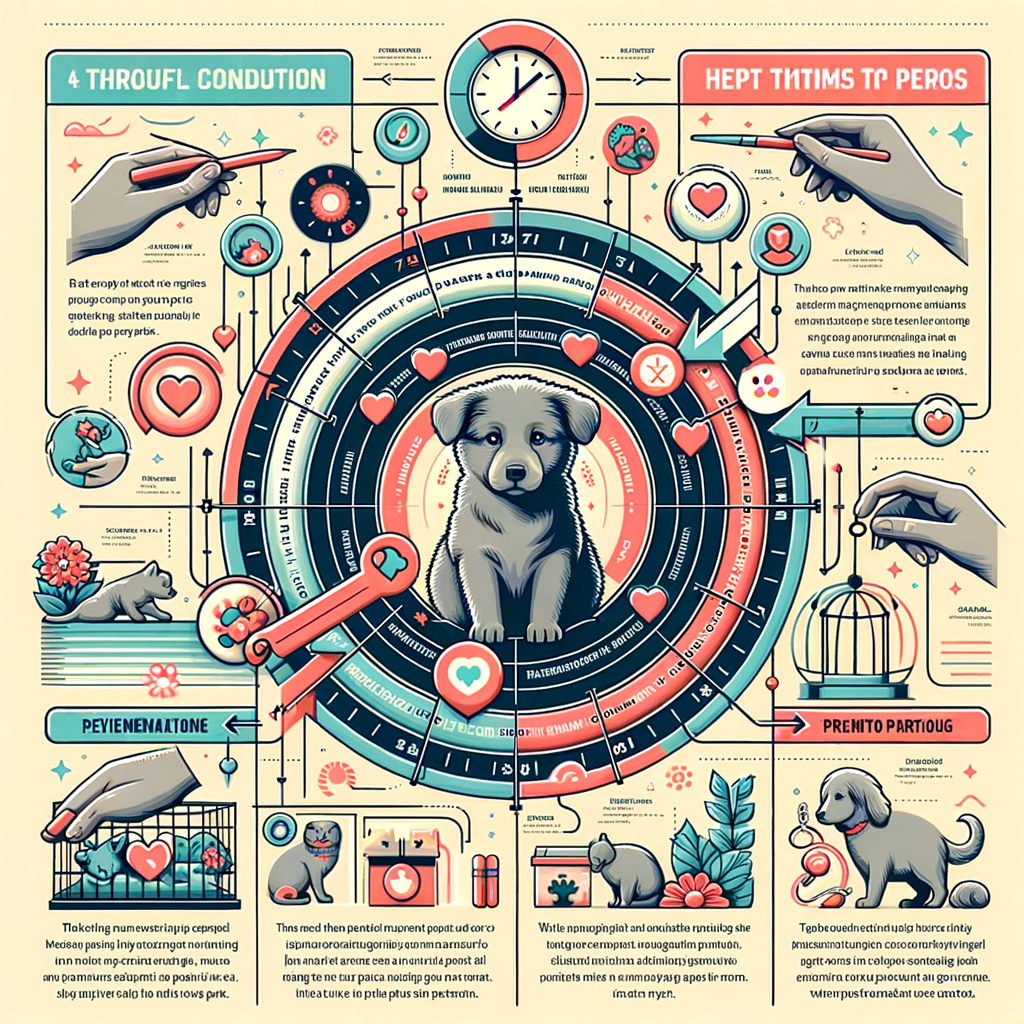
Introduction: Timing is Everything in Pet Adoption
Adopting a pet is a joyous and life-changing event. However, it’s not just about choosing the right pet; it’s also about the right timing. This article will explore why timing is crucial in the pet adoption process and provide you with valuable insights to guide your pet adoption journey.
- Importance of timing in the pet adoption process:
- Overview of the article:
Timing plays a pivotal role in the pet adoption process. It’s not just about when the pet is available for adoption, but also about when you, as a potential pet owner, are ready to welcome a new member into your family. The right timing can ensure a smoother transition for both you and your new pet, leading to a more fulfilling and lasting bond.
This article will delve into the intricacies of pet adoption, highlighting the importance of timing. We will discuss the factors to consider when choosing a pet and identify the best time for pet adoption. By the end of this article, you will be better equipped to make an informed decision about adopting a pet, ensuring a happy and healthy life for your new furry friend.
Let’s embark on this journey of understanding pet adoption, its timing, and its impact on your life and the life of your soon-to-be pet.
Understanding Pet Adoption
Adopting a pet is a big decision. It’s not just about bringing a cute animal into your home. It’s about making a commitment to care for that animal for its entire life. Let’s delve into what pet adoption really means.
What is Pet Adoption?
Pet adoption is a process where an individual or family decides to take responsibility for a pet that has been abandoned or relinquished by its previous owner. This process involves a lot more than just picking out a pet and bringing it home. Let’s break it down.
- Definition of pet adoption: Pet adoption is when a person or family takes in a pet that needs a home. This can be through a shelter, a rescue group, or even a private adoption. The person or family then becomes responsible for the pet’s care, including feeding, grooming, and medical needs.
- Different types of pet adoption: There are several types of pet adoption. The most common is adopting from a shelter or rescue group. These organizations take in pets that have been abandoned or given up by their previous owners. Another type of adoption is private adoption, where a pet is adopted directly from its previous owner. Finally, there are breed-specific rescues that focus on finding homes for specific breeds of dogs or cats.
Understanding the different types of pet adoption can help you make the best decision for your family and for the pet you are considering. Remember, adopting a pet is a lifelong commitment and should not be taken lightly.
The Pet Adoption Process
Adopting a pet is a rewarding experience, but it’s also a serious commitment. It’s important to understand the process to ensure a smooth transition for both you and your new pet. Let’s break down the pet adoption process into four main steps.
- Initial Considerations
- Choosing a Pet
- The Adoption Process
- Post-Adoption Responsibilities
Before you even start looking for a pet, take some time to think about your lifestyle, living conditions, and personal preferences. Do you have enough time to devote to a pet? Can you afford the costs of pet care? What kind of pet would be the best fit for your home and family? These are all important questions to consider.
Once you’ve thought about your initial considerations, the next step is to choose a pet. This involves researching different breeds and species, considering their needs and temperaments. Remember, every pet is unique, so it’s important to find one that matches your lifestyle and personality.
The actual adoption process can vary depending on the organization, but it generally involves filling out an application, meeting with the pet, and going through an interview process. Some organizations may also require a home visit. The goal of this process is to ensure that the pet is a good fit for your home and that you are prepared to take on the responsibility of pet ownership.
After you’ve adopted your pet, your responsibilities don’t end. You’ll need to provide ongoing care for your pet, including regular vet visits, feeding, exercise, and training. It’s also important to give your pet plenty of love and attention to help them adjust to their new home.
In conclusion, adopting a pet is a big decision that involves careful consideration and preparation. By understanding the process, you can ensure that you’re ready to welcome a new member into your family and provide them with a loving home.
Choosing a Pet: Factors to Consider
When it comes to choosing a pet, there are several factors that you need to consider. One of the most important aspects to consider is your lifestyle. Understanding your lifestyle can help you make the right decision in choosing a pet that suits you best.
Understanding Your Lifestyle
Your lifestyle plays a significant role in determining the kind of pet that would be a good fit for you. Here are some key factors to consider:
- Assessing your living situation: The first thing to consider is your living situation. Do you live in an apartment or a house? Do you have a backyard or a park nearby? Some pets, like dogs, require more space and outdoor time than others. If you live in a small apartment, a smaller pet like a cat or a fish might be a better fit.
- Considering your daily routine: Your daily routine is another crucial factor. Pets require time and attention. If you have a busy schedule, you might not have enough time to take care of a pet that needs a lot of care and attention, like a dog. In such cases, a pet that requires less attention, like a fish or a turtle, might be a better fit.
- Financial considerations: Pets can be expensive. They require food, medical care, and other supplies. Before getting a pet, you should consider whether you can afford to take care of it. Remember, it’s not just about the initial cost of buying the pet, but also the ongoing costs of taking care of it.
In conclusion, understanding your lifestyle is crucial in choosing the right pet for you. By assessing your living situation, considering your daily routine, and taking into account your financial situation, you can make a well-informed decision that will ensure a happy and healthy life for both you and your pet.
Choosing the Right Pet for You
Choosing the right pet for you is a significant decision that requires careful consideration. Here are some factors to consider:
- Understanding different pet breeds and species
- Considering the pet’s age
- Health considerations
Different pet breeds and species have unique characteristics, needs, and behaviors. For example, some dog breeds need a lot of exercise, while others are more laid back. Some cat breeds are known for their playful nature, while others are more reserved. It’s essential to research and understand the needs of different pet breeds and species to ensure they align with your lifestyle.
The age of the pet is another crucial factor to consider. Puppies and kittens require a lot of time, patience, and training. They’re also full of energy and can be a handful. On the other hand, older pets are usually more relaxed and may already be trained. However, they may also have health issues that require special care. It’s important to consider your lifestyle and the amount of time you can dedicate to your pet before deciding on their age.
Before adopting a pet, it’s important to consider their health. Some breeds are prone to specific health issues. For example, some dog breeds are more likely to develop hip dysplasia, while some cat breeds are prone to obesity. It’s essential to understand these potential health issues and consider if you’re prepared to handle them. Also, regular vet check-ups are crucial to ensure your pet stays healthy.
In conclusion, choosing the right pet involves understanding different pet breeds and species, considering the pet’s age, and taking into account health considerations. It’s a decision that should not be taken lightly, but with the right information and consideration, you can find the perfect pet for you.
Best Time for Pet Adoption
Choosing the right time to adopt a pet is just as important as deciding on the type of pet that suits your lifestyle. The timing can significantly impact your pet adoption experience. Let’s explore some key considerations to keep in mind when deciding when to adopt a pet.
When to Adopt a Pet: Key Considerations
There are several factors to consider when determining the best time to bring a new pet into your home. Here are three crucial points to ponder:
- Personal readiness: Adopting a pet is a long-term commitment. You need to ensure that you are mentally, emotionally, and financially prepared for the responsibility. This includes being ready to provide for the pet’s needs, such as food, medical care, and attention.
- Availability of time: Pets, especially puppies and kittens, require a lot of time and attention. If you’re too busy with work or other commitments, it might not be the best time to adopt. Ensure you have enough time to train, socialize, and care for your new pet.
- Seasonal considerations: The time of year can also influence your pet adoption decision. For instance, adopting a puppy during the summer might be easier as the warmer weather is conducive to outdoor training and socialization. On the other hand, adopting a pet during the holiday season may not be ideal due to the hustle and bustle that often accompanies this time of year.
Remember, the best time for pet adoption is when you’re fully prepared to welcome and care for a new member in your family. It’s a decision that should not be rushed, as it involves a commitment to provide a loving home for your pet for its entire life.
Pet Adoption Timing: Case Studies
Let’s delve into some real-life scenarios to better understand the timing of pet adoption. Here are two case studies that highlight the importance of timing when adopting a pet.
- Case study 1: Adopting a pet during a vacation
- Case study 2: Adopting a pet during a major life change
Meet Jane, a busy professional who decided to adopt a pet during her summer vacation. She had always wanted a pet but her work schedule didn’t allow her the time to properly care for one. During her vacation, she had ample time to bond with her new pet, a playful puppy named Max. This time allowed her to understand Max’s needs, train him, and establish a routine. By the time she returned to work, Max was well-adjusted and she was able to balance her work and pet responsibilities effectively. This case study highlights the importance of having sufficient time to bond with and train your new pet.
Now, let’s consider John, who adopted a cat during a major life change – his retirement. John had always been a cat lover but never had the time to care for one. When he retired, he decided it was the perfect time to adopt a cat. The cat, Bella, provided companionship and a sense of purpose to John’s newly retired life. Bella’s care routine gave structure to John’s day, and her companionship alleviated feelings of loneliness that can sometimes accompany retirement. This case study underscores the potential benefits of adopting a pet during a major life change, provided that the change leads to more free time and not less.
In conclusion, the timing of pet adoption can significantly influence the success of the adoption process. Both Jane and John’s stories illustrate that having ample time to bond with and care for your pet is crucial. Whether it’s during a vacation or a major life change like retirement, the key is to ensure that you have the time and resources to provide your new pet with a loving and caring environment.
Conclusion: Making Your Pet Adoption Decision
Adopting a pet is a significant decision that requires careful consideration. The timing of your adoption can greatly impact both your life and the life of your new pet. Let’s recap the key factors we’ve discussed in this article.
- Recap of key factors in pet adoption timing
- Final thoughts on choosing when to adopt a pet
Firstly, we discussed the importance of personal readiness. This includes having the necessary time, financial resources, and emotional capacity to care for a pet. We also touched on the significance of the pet’s age and health status, as well as the time of year. For instance, adopting during a quieter period in your life can help ease the transition for both you and your pet.
Ultimately, the best time to adopt a pet is when you feel fully prepared to welcome a new member into your family. Remember, pet adoption is a long-term commitment that can last for many years. It’s essential to ensure you’re making the right decision at the right time. By considering all the factors we’ve discussed, you can make an informed decision that will lead to a rewarding and loving relationship with your new pet.
In conclusion, pet adoption is a wonderful journey filled with love and companionship. By taking the time to understand and consider all aspects of pet adoption, you can ensure that you’re making the best decision for both you and your future pet. Remember, the right time to adopt is different for everyone. It’s about finding the perfect fit for your lifestyle and being ready to provide a loving and caring home for your new pet.






